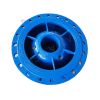Mar. 21, 2024
Nozzle check valves are unsung heroes of fluid systems, quietly ensuring the smooth and efficient flow of liquids or gases while preventing the dreaded backflow. In this guide, we'll delve into the purpose of nozzle check valves, addressing common questions and concerns surrounding their functionality and importance.
Understanding the Purpose of Nozzle Check Valves
At its core, a nozzle check valve is designed to regulate the flow of fluids or gases in a system by allowing them to move in one direction while blocking reverse flow. This simple yet ingenious mechanism plays a crucial role in maintaining the integrity and efficiency of various fluid systems across industries.
Preventing Backflow: The Primary Function
The primary purpose of a nozzle check valve is to prevent backflow, which occurs when fluids or gases flow in the opposite direction than intended. Backflow can lead to a myriad of issues, including contamination, damage to equipment, loss of pressure, and compromised system performance. Nozzle check valves act as gatekeepers, ensuring that once fluid or gas passes through, it cannot return, thereby safeguarding the system from potential harm.
Common Questions and Concerns Addressed
Why is backflow prevention important? Backflow poses significant risks to fluid systems, including contamination of clean water supplies, damage to sensitive equipment, and safety hazards in industrial settings. Nozzle check valves provide a crucial line of defense against these threats, maintaining the reliability and safety of the system.

How do nozzle check valves work? Nozzle check valves utilize a simple yet effective design, typically featuring a hinged or spring-loaded mechanism that opens to allow fluid or gas flow in one direction and closes to prevent reverse flow. This mechanism ensures that pressure from the forward flow keeps the valve open while effectively sealing it shut when flow direction reverses.
Where are nozzle check valves used? Nozzle check valves find widespread applications across various industries, including plumbing, wastewater treatment, chemical processing, oil and gas production, and HVAC systems. They are commonly employed in pumps, compressors, pipelines, and other fluid-handling equipment to maintain flow directionality and system integrity.
What are the benefits of using nozzle check valves? The benefits of nozzle check valves extend beyond backflow prevention. These valves help optimize system performance by minimizing pressure drops, reducing energy consumption, and prolonging the lifespan of equipment. Additionally, they enhance safety by preventing potential accidents or spills caused by backflow events.
Conclusion: Ensuring Fluid System Integrity with Nozzle Check Valves
Disai Nozzle check valves may be small in size, but their impact on fluid systems is monumental. By preventing backflow and maintaining flow directionality, these valves play a crucial role in ensuring the reliability, efficiency, and safety of fluid-handling processes across industries. Understanding their purpose and functionality is essential for optimizing system performance and minimizing risks associated with backflow events.
266
0
0
All Comments (0)
Previous: What is the difference between 2pc and 3pc ball valves?
Next: What is the difference between a gate valve and a wedge valve?
If you are interested in sending in a Guest Blogger Submission,welcome to write for us!
Comments